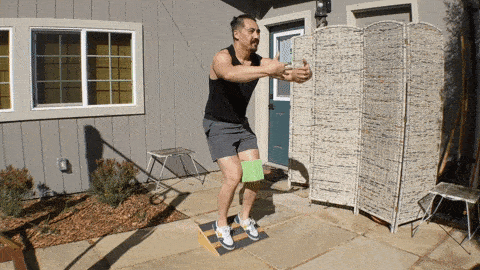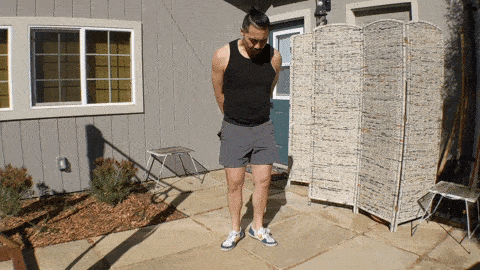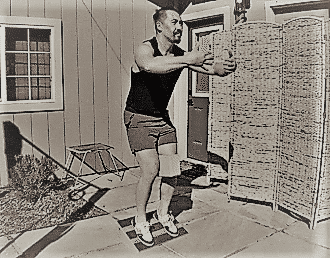Here’s how you can begin working with knee-pain and get stronger right now.
A common strategy for relieving knee pain is to begin losing weight. Doctors will tell you that if your knee has less load to bear, it won’t struggle. But the truth is, the muscles around your knee need to be gradually trained to function in a different way.

The Narrow-Stance Deep-Knee Bend:
-
- Find an object to place under your heels (a yoga block or a book), and keep your toes pointed forward and 6-8″ apart.
- Hold your hands ahead of you to keep balanced, preferably squeezing another a block between your hands like you’re crushing a soda can.
- Bend both knees first while continuously squeezing the block. If this feels hard, simply put one hand on a chair to help with balance.
- Go as deep as possible, touching the back of the legs to the calves, in a controlled tempo of 2-seconds down, and 1-second standing up.
- Repeat until you have 1-2 reps left in reserve, meaning you feel like you could still do 1-2 more. At this point, take a short break and see how you feel.
- If after the rest, you feel like you can do another round, do so. If not, you are complete for now.
This exercise will grow your capability but it is also a diagnostic, meaning it helps you assess how your knees and legs are feeling today. If it’s easier, you have more readiness for movement. If it’s harder, you should use one or both of your hands on a wall and chair to push you up, and know that you’re having a “recovery day” instead of a “growth day.” (I will share more about recovery vs growth days and self-assessing for maximizing your personal training in the future.)
If you want to turn this exercise into a knee-strengthener, focus on tightening your chest and core muscles by squeezing the block hard before bending the knees.

The Plié (Wide-Stance Deep-Knee Bend):
-
- Start with your heels together and toes pointed out like wings. You will not need any props under the heels.
- Hold your hands behind your back, and lean slightly forward to balance yourself.
- Bend both knees until the backs of your thighs reach your calves, and your heels peels off of the ground slightly.
- Repeat until you have 1-2 reps left in reserve, meaning you feel like you could still do 1-2 more. At this point, take a short break and see how you feel.
- If after the rest, you feel like you can do another round, do so. If not, you are complete for now.
- If you try this and it feels fairly easy, hold a weight of 5-10lbs to add a bit of challenge.
This exercise is also a diagnostic, but can be turned into a strengthener by adding weight or by slowing way down on the descent and ascent, like taking 3-4 second to go down and 2-3 seconds to come all the way up.

